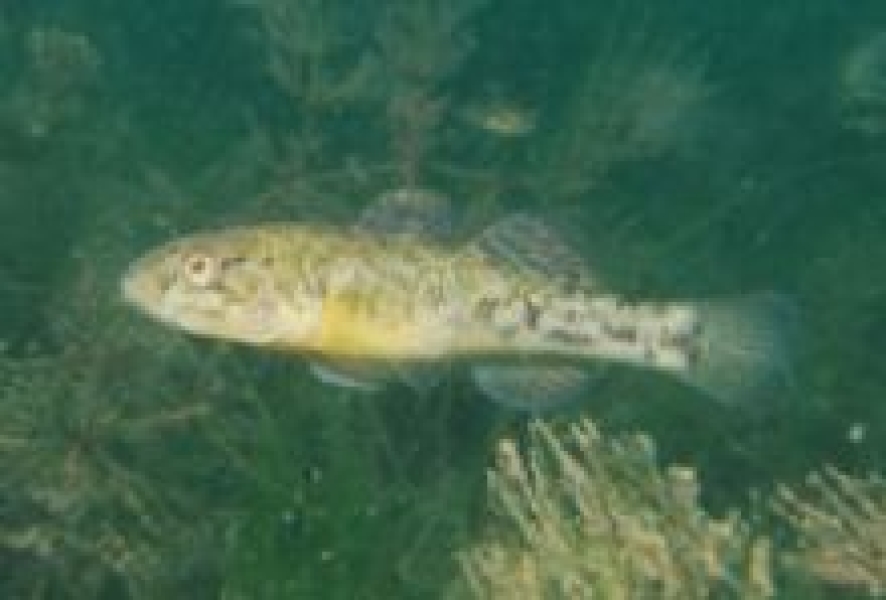One of the most common species of freshwater fish in Aotearoa is the common bully or toitoi.
Common name: Common bully Scientific name: Gobiomorphus cotidianus Māori name: includes toitoi
About this species
There are several species of freshwater bully in the waterways around Aotearoa, one of the most common species is the common bully or toitoi. The toitoi is a small fish reaching an average size of 50-60 mm. This fish has a broad head and is usually dark grey to brown in colour. Toitoi live in gently flowing streams and can form land-locked (no journey to sea) lake populations. Toitoi prefer sandy to gravelly streams or lake beds. They can be seen in the open but often seek cover, especially during high water flows.
Toitoi are a lowland species with limited climbing ability. Dams at low elevation or on low gradient waterways have the potential to impact this species.
Traditional knowledge
There are accounts of the historic importance of this species in lake habitats such as the Te Arawa Lakes. Tumu (marker posts) were often used to mark the position of a fishing ground and were also used to fasten one end of the tau of ake vine which carried fern bundles used to capture sheltering toitoi.
Impacts on toitoi
Natural pollutants such as ammonia, which occurs in livestock waste and poorly treated wastewater, can adversely affect fish populations through displacement and, at high concentrations, death. In tests, toitoi were found to be the fourth most sensitive species to ammonia toxicity.
Toitoi have been found to prefer warmer temperatures between 20°C and 22°C with an upper lethal temperature of approximately 30°C.
In laboratory trials, toitoi appeared to prefer alkaline waters with a pH of 8.7 and fish were able to survive dissolved oxygen levels as low as 3mg/L.
Bully abundance can increase in lakes as they become more enriched and turbid (i.e., they can thrive in degraded environments).
References and further reading
Find papers relevant to all Aotearoa freshwater fish on our reference page
Toitoi, common bully
- Glova, G. J., Sagar, P. M. 2000. Summer spatial patterns of the fish community in a large, shallow, turbid coastal lake. New Zealand Journal of Marine and Freshwater Research 34(3): 507-522.
- Jellyman, D. J., Glova, G.J., Sagar, P.M., Sykes, J.R.E. 1997. Spatio-temporal distribution of fish in the Kakanui River estuary, South Island, New Zealand. New Zealand Journal of Marine and Freshwater Research 31(1): 103-118.
- Kattel, G. R., Closs, G. P. 2007. Spatial and temporal variation in the fish community of a South Island, New Zealand coastal lake. New Zealand Journal of Marine and Freshwater Research 41: 1-11.
- Landman, M. J., Van Den Heuvel, M. R., Ling, N. 2005. Relative sensitivities of common freshwater fish and invertebrates to acute hypoxia. New Zealand Journal of Marine and Freshwater Research 39(5): 1061-1067.
- Rowe, D. K. 1999. Factors influencing the abundance of the common bully, Gobiomorphus cotidianus McDowall, in small, North Island, New Zealand, lakes. Fisheries Management and Ecology 6(5): 377–386.
- Rowe, D., Graynoth, E., James, G., Taylor, M., Hawke, L. 2003. Influence of turbidity and fluctuating water levels on the abundance and depth distribution of small, benthic fish in New Zealand alpine lakes. Ecology of Freshwater Fish 12: 216-227.
- Sagar, P. M., Eldon, G. A. 1983. Food and feeding of small fish in the Rakaia River, New Zealand. New Zealand Journal of Marine and Freshwater Research 17(3): 213-226.
- Sagar, P. M., Glova, G. J. 1994. Food partitioning by small fish in a coastal New Zealand stream. New Zealand Journal of Marine and Freshwater Research 28(4): 429-436.


